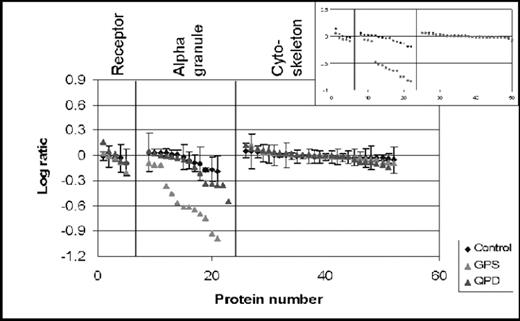Abstract
Qualitative platelet defects are a heterogeneous group of disorders characterized by abnormal platelet function. Currently available laboratory assays lack sensitivity and specificity for detecting Storage Pool and Platelet Secretion defects. The Gray Platelet Syndrome (GPS) is an autosomal recessive disorder characterized by a decrease or absence of alpha granule contents. The Quebec Platelet Disorder (QPD) results from proteolysis of alpha granule proteins due to increased amounts of platelet urokinase. A decrease or deficiency of multimerin is characteristic. Proteomics is a rapidly developing field with great promise in the study of pathophysiology and biomarker development. Recent advances have made measurement of relative protein abundance in multiple samples feasible. We used one such approach, “isotope Tagging for Relative and Absolute Quantitation” (iTRAQ) to characterize the platelet proteome of healthy volunteers and patients with GPS and QPD. iTRAQ allows analysis of up to 4 different samples simultaneously, and differences in protein abundance as low as 20% are reliably detected. The platelet proteomes of 4 healthy volunteers were analyzed. Platelet proteome analysis of study patients was as follows;
2 GPS patients compared to 2 controls;
2 heterozygous GPS patients compared to a homozygote and a control; and
3 QPD patients compared to a control.
For comparison, platelet proteins were grouped by location into 3 groups - receptor, alpha granule and cytoskeletal proteins. The results are shown in the figure. Protein abundance in healthy volunteers was very consistent, with inter-individual variability ≤ 20%. Distribution of receptor and cytoskeletal proteins in GPS patients mirrored the controls, but alpha granule proteins were significantly decreased as expected. Comparison of homozygous to heterozygous GPS platelets showed this to be true only in the homozygotes, again, as expected (figure inset). Variable decreases in alpha granule proteins were observed in QPD patients but this was less profound. Multimerin was detected in QPD patients, but at levels significantly lower than controls. While urokinase was not detected in QPD platelets in this study, it was detected in a parallel study evaluating platelet releasates. The iTRAQ technique was reproducible and yielded consistent results, but currently is a relatively expensive and time-consuming approach. In summary, our results suggest that the platelet proteome is tightly regulated and very stable in healthy individuals. A significant decrease in alpha granule proteins was noted in patients with GPS but this was less remarkable in the QPD group, probably because peptides resulting from urokinase-mediated proteolysis are still labeled and quantified.
Author notes
Disclosure: No relevant conflicts of interest to declare.


This feature is available to Subscribers Only
Sign In or Create an Account Close Modal